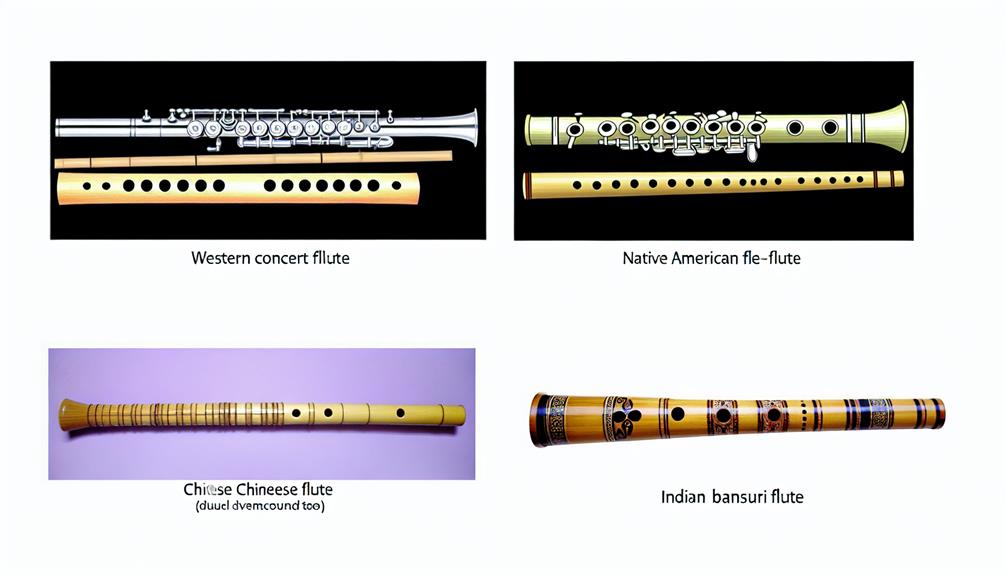The realm of music is a vast landscape with various instruments that contribute to its rich tapestry of sounds. When we think of flutes, the mind often drifts to the elegant Concert Flute, a staple in classical and orchestral music.
However, beyond this familiar instrument lie three others that add depth and diversity to the flute family. Each possessing its own unique characteristics, these lesser-known flutes have carved their own niche in different musical genres.
The exploration of these four types of flutes promises to unveil a world of sonic possibilities waiting to be discovered.
Key Takeaways
- Concert Flute: Versatile, clear tone, over three octaves, popular choice for all levels.
- Alto Flute: Warmer sound, unique timbre, used in various ensembles, requires technical mastery.
- Bass Flute: Resonant voice, rich tone, expands tonal possibilities, requires skillful navigation.
- Piccolo: Highest pitch, brilliance, versatile in genres, requires high skill and control.
Concert Flute
The Concert Flute, also known as the Western concert flute, is a widely recognized and versatile member of the flute family, commonly used in orchestras and solo performances. With its bright and clear tone, the concert flute is a staple instrument in classical music, jazz ensembles, and various other genres. Its elegant design and compact size make it a popular choice for both beginner and advanced flutists seeking a well-rounded instrument.
One of the defining features of the concert flute is its range, spanning over three octaves and capable of producing lyrical melodies and agile passages with ease. The instrument's cylindrical bore and key system allow for precise intonation and intricate fingering techniques, enabling musicians to express a wide range of emotions through their playing.
Whether performing as part of a symphony orchestra, a chamber ensemble, or as a soloist, the concert flute offers a sense of belonging to flutists worldwide, connecting them through a shared love for this beautiful and expressive instrument.
Alto Flute
Commonly overlooked in favor of its smaller counterpart, the alto flute offers a rich and unique timbre that adds depth to ensemble performances. Despite its lower pitch, the alto flute holds a significant place in the world of music, contributing its own distinctive voice to various musical arrangements.
- Size and Pitch: The alto flute is larger than the traditional concert flute and is pitched in the key of G, a perfect fourth below the concert flute. This difference in size and pitch allows the alto flute to produce a warmer and more mellow sound quality.
- Versatility: While the alto flute is commonly used in flute choirs and orchestral settings to provide a rich harmonic foundation, it is also featured in solo and chamber music repertoire. Its unique timbre adds a layer of complexity and emotional depth to musical compositions.
- Technical Challenges: Due to its larger size and lower pitch, playing the alto flute requires adjustments in fingering techniques and breath control compared to the concert flute. Mastery of these technical aspects is essential for a proficient performance on the alto flute.
Bass Flute
Often overshadowed by its more well-known counterparts, the bass flute offers a distinctive and resonant voice within the realm of woodwind instruments. While its larger size and lower pitch may not be as common in orchestras or ensembles, the bass flute provides a rich and deep tone that adds a unique color to musical compositions. With a range that extends lower than the concert flute, the bass flute is capable of producing a warm and velvety sound that captivates listeners.
Despite its lesser prominence, the bass flute plays a crucial role in expanding the tonal possibilities of a musical ensemble. Its presence can evoke a sense of depth and gravity, enhancing the overall texture of a piece. Skilled musicians appreciate the challenges and rewards that come with mastering the bass flute, including navigating its extended reach and adjusting to its distinct embouchure.
In the hands of a proficient player, the bass flute shines as a versatile instrument capable of conveying a wide range of emotions and moods, making it a valuable addition to any woodwind section.
Piccolo
Seldom seen as a diminutive powerhouse in orchestras and marching bands alike, the piccolo is a small yet mighty woodwind instrument that commands attention with its piercingly high and bright notes. Despite its size, the piccolo plays a crucial role in adding brilliance and color to musical compositions.
Here are three key points about the piccolo:
- Size and Structure: The piccolo is the highest-pitched instrument in the woodwind family and is half the size of a standard flute. It is usually about 32 cm in length and is played horizontally like a flute. Despite its small size, the piccolo's sound can easily soar above the rest of the orchestra.
- Versatility: While often associated with classical music, the piccolo is a versatile instrument that can be found in various genres, including jazz and military music. Its ability to cut through loud environments makes it a favorite in marching bands.
- Challenges: Playing the piccolo requires a high level of skill and control due to its small size and high pitch. Musicians must have strong embouchure muscles and precise fingerings to produce clear and accurate notes.
Frequently Asked Questions
What Are the Differences in Playing Techniques Between the Four Types of Flutes Mentioned?
Mastering different playing techniques among the four types of flutes requires understanding unique embouchure, fingerings, and breath control for each. From the transverse flute's vibrant sound to the deep resonance of the bass flute, nuances demand precision and skill.
Are There Any Notable Musicians or Composers Known for Their Work With Each Type of Flute?
Renowned musicians and composers have elevated flutist artistry across various types of flutes. Each flute type boasts a rich history of virtuosos who have graced the world stage with their mesmerizing performances, leaving a lasting legacy in musical history.
How Do the Sizes and Shapes of the Different Flutes Affect Their Sound and Range?
The sizes and shapes of flutes significantly impact their sound and range. Larger flutes generally produce lower pitches and have a broader range, while smaller flutes tend to create higher pitches with a more limited range.
Are There Any Specific Genres or Styles of Music That Each Type of Flute Is Commonly Used In?
When considering the specific genres or styles of music each type of flute is commonly used in, it is important to recognize the unique characteristics and tonal qualities that distinguish these flutes.
Are There Any Unique Features or Characteristics of Each Type of Flute That Set Them Apart From the Others?
Each type of flute possesses unique features and characteristics that distinguish it from the others, such as varying sizes, materials, and playing techniques. Understanding these distinctions is essential for mastering the intricacies of each flute type.
Conclusion
In conclusion, the four types of flutes mentioned are the Concert Flute, Alto Flute, Bass Flute, and Piccolo. Each of these flutes has its own unique characteristics and range, making them versatile instruments in various musical settings.
As the saying goes, 'different strokes for different folks,' these flutes cater to a wide range of musical preferences and styles, ensuring that there is a flute for every musician's needs.

